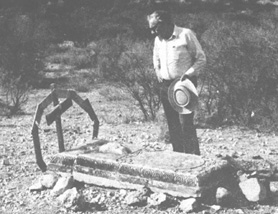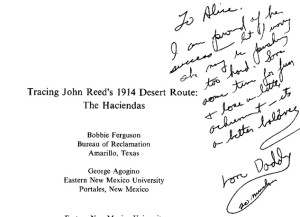| “At some point between late December 1913 and early January 1914 American journalist John Reed succeeded in getting across the border at Presidio, Texas, into Mexico. Unlike other journalists of his period who filed their reports from the comfort of “headquarters,” Reed sought and found ways to join the revolutionary troops at the front. His goal was not only to report the events, the facts of the war in progress, but to capture the essence of the feelings of those fighting it as well. |  George Agogino at the isolated grave of Tomas Urbina R. |
He succeeded completely; the exquisite, concise verbal portraits and murals of Insurgent Mexico are photographic in their exactness and brilliant in their insights. The book, which he dedicated in July 1914. includes episodes filed from Mexico during that Spring of 1914 to Metropolitan Magazine and the New York World in New York City.
It was not until many years after John Reed became known as the founder of the modern school of creative journalism for his Ten Days that Shook the World that Insurgent Mexico was dusted off and reprinted. The copy of Insurgent Mexico from which this monograph quotes was copyrighted in 1969. It was discovered by Dr. George Agogino while browsing through the Mexico section of the Eastern New Mexico University library in 1974. Excited by its new perspective and clarity, Dr. Agogino shared his find with Bobbie Ferguson, a co-worker on other Mexican research projects.
As we read the chapters we were overwhelmed with the way in which Reed described scenes we knew — so completely with so few words. We were addicted; we had to do something with this magnificent find. In the first part of Insurgent Mexico, after filing initial descriptions from Ojinaga, Reed reports his travels some two hundred miles through the northern part of the state of Durango with a small guerrilla force, moving from hacienda to hacienda enroute to La Cadena where a small number of revolutionaries guarded a critical mountain pass. At each stop, and between, he describes the occurrences and surroundings. Could we, using the descriptions, locate and photograph those haciendas as they are today? We had no illusions that we could equal Reed’s verbal descriptions, but perhaps we could complement and pay tribute to them with photographs. We could also comment briefly on the present condition and use of the haciendas as compared with their singular functions in 1914.
— Bobbie Ferguson and George Agogino, 1979

Cover with note to daughter Alice saying he is worried that she is working to hard.
Return
Last updated by Alice M. Agogino, 31 March 2006